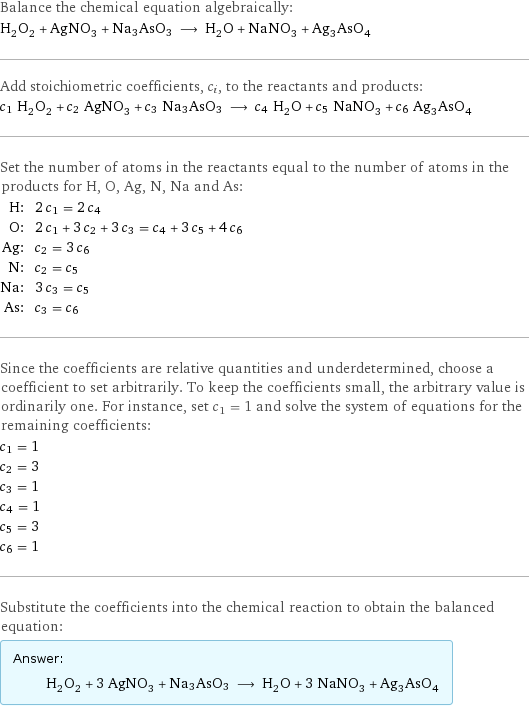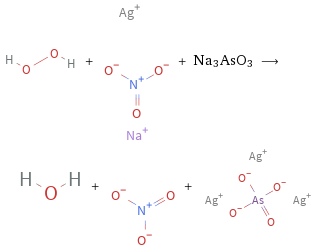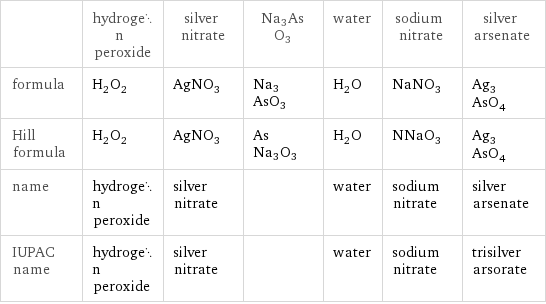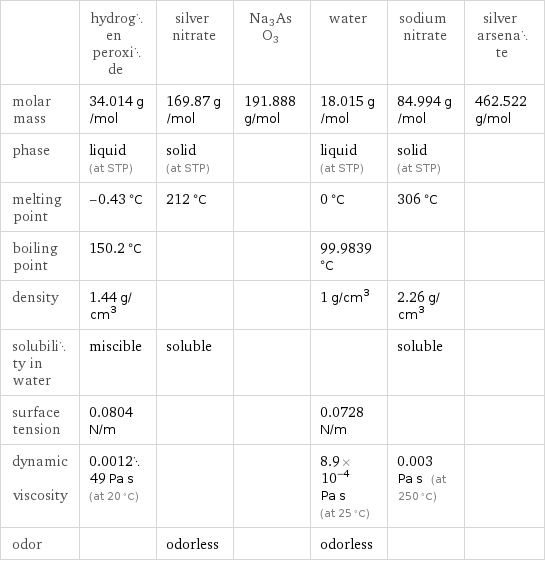Input interpretation

H_2O_2 hydrogen peroxide + AgNO_3 silver nitrate + Na3AsO3 ⟶ H_2O water + NaNO_3 sodium nitrate + Ag_3AsO_4 silver arsenate
Balanced equation

Balance the chemical equation algebraically: H_2O_2 + AgNO_3 + Na3AsO3 ⟶ H_2O + NaNO_3 + Ag_3AsO_4 Add stoichiometric coefficients, c_i, to the reactants and products: c_1 H_2O_2 + c_2 AgNO_3 + c_3 Na3AsO3 ⟶ c_4 H_2O + c_5 NaNO_3 + c_6 Ag_3AsO_4 Set the number of atoms in the reactants equal to the number of atoms in the products for H, O, Ag, N, Na and As: H: | 2 c_1 = 2 c_4 O: | 2 c_1 + 3 c_2 + 3 c_3 = c_4 + 3 c_5 + 4 c_6 Ag: | c_2 = 3 c_6 N: | c_2 = c_5 Na: | 3 c_3 = c_5 As: | c_3 = c_6 Since the coefficients are relative quantities and underdetermined, choose a coefficient to set arbitrarily. To keep the coefficients small, the arbitrary value is ordinarily one. For instance, set c_1 = 1 and solve the system of equations for the remaining coefficients: c_1 = 1 c_2 = 3 c_3 = 1 c_4 = 1 c_5 = 3 c_6 = 1 Substitute the coefficients into the chemical reaction to obtain the balanced equation: Answer: | | H_2O_2 + 3 AgNO_3 + Na3AsO3 ⟶ H_2O + 3 NaNO_3 + Ag_3AsO_4
Structures

+ + Na3AsO3 ⟶ + +
Names

hydrogen peroxide + silver nitrate + Na3AsO3 ⟶ water + sodium nitrate + silver arsenate
Equilibrium constant
![Construct the equilibrium constant, K, expression for: H_2O_2 + AgNO_3 + Na3AsO3 ⟶ H_2O + NaNO_3 + Ag_3AsO_4 Plan: • Balance the chemical equation. • Determine the stoichiometric numbers. • Assemble the activity expression for each chemical species. • Use the activity expressions to build the equilibrium constant expression. Write the balanced chemical equation: H_2O_2 + 3 AgNO_3 + Na3AsO3 ⟶ H_2O + 3 NaNO_3 + Ag_3AsO_4 Assign stoichiometric numbers, ν_i, using the stoichiometric coefficients, c_i, from the balanced chemical equation in the following manner: ν_i = -c_i for reactants and ν_i = c_i for products: chemical species | c_i | ν_i H_2O_2 | 1 | -1 AgNO_3 | 3 | -3 Na3AsO3 | 1 | -1 H_2O | 1 | 1 NaNO_3 | 3 | 3 Ag_3AsO_4 | 1 | 1 Assemble the activity expressions accounting for the state of matter and ν_i: chemical species | c_i | ν_i | activity expression H_2O_2 | 1 | -1 | ([H2O2])^(-1) AgNO_3 | 3 | -3 | ([AgNO3])^(-3) Na3AsO3 | 1 | -1 | ([Na3AsO3])^(-1) H_2O | 1 | 1 | [H2O] NaNO_3 | 3 | 3 | ([NaNO3])^3 Ag_3AsO_4 | 1 | 1 | [Ag3AsO4] The equilibrium constant symbol in the concentration basis is: K_c Mulitply the activity expressions to arrive at the K_c expression: Answer: | | K_c = ([H2O2])^(-1) ([AgNO3])^(-3) ([Na3AsO3])^(-1) [H2O] ([NaNO3])^3 [Ag3AsO4] = ([H2O] ([NaNO3])^3 [Ag3AsO4])/([H2O2] ([AgNO3])^3 [Na3AsO3])](../image_source/a83890c6345b27895f0d0b7c25f908fa.png)
Construct the equilibrium constant, K, expression for: H_2O_2 + AgNO_3 + Na3AsO3 ⟶ H_2O + NaNO_3 + Ag_3AsO_4 Plan: • Balance the chemical equation. • Determine the stoichiometric numbers. • Assemble the activity expression for each chemical species. • Use the activity expressions to build the equilibrium constant expression. Write the balanced chemical equation: H_2O_2 + 3 AgNO_3 + Na3AsO3 ⟶ H_2O + 3 NaNO_3 + Ag_3AsO_4 Assign stoichiometric numbers, ν_i, using the stoichiometric coefficients, c_i, from the balanced chemical equation in the following manner: ν_i = -c_i for reactants and ν_i = c_i for products: chemical species | c_i | ν_i H_2O_2 | 1 | -1 AgNO_3 | 3 | -3 Na3AsO3 | 1 | -1 H_2O | 1 | 1 NaNO_3 | 3 | 3 Ag_3AsO_4 | 1 | 1 Assemble the activity expressions accounting for the state of matter and ν_i: chemical species | c_i | ν_i | activity expression H_2O_2 | 1 | -1 | ([H2O2])^(-1) AgNO_3 | 3 | -3 | ([AgNO3])^(-3) Na3AsO3 | 1 | -1 | ([Na3AsO3])^(-1) H_2O | 1 | 1 | [H2O] NaNO_3 | 3 | 3 | ([NaNO3])^3 Ag_3AsO_4 | 1 | 1 | [Ag3AsO4] The equilibrium constant symbol in the concentration basis is: K_c Mulitply the activity expressions to arrive at the K_c expression: Answer: | | K_c = ([H2O2])^(-1) ([AgNO3])^(-3) ([Na3AsO3])^(-1) [H2O] ([NaNO3])^3 [Ag3AsO4] = ([H2O] ([NaNO3])^3 [Ag3AsO4])/([H2O2] ([AgNO3])^3 [Na3AsO3])
Rate of reaction
![Construct the rate of reaction expression for: H_2O_2 + AgNO_3 + Na3AsO3 ⟶ H_2O + NaNO_3 + Ag_3AsO_4 Plan: • Balance the chemical equation. • Determine the stoichiometric numbers. • Assemble the rate term for each chemical species. • Write the rate of reaction expression. Write the balanced chemical equation: H_2O_2 + 3 AgNO_3 + Na3AsO3 ⟶ H_2O + 3 NaNO_3 + Ag_3AsO_4 Assign stoichiometric numbers, ν_i, using the stoichiometric coefficients, c_i, from the balanced chemical equation in the following manner: ν_i = -c_i for reactants and ν_i = c_i for products: chemical species | c_i | ν_i H_2O_2 | 1 | -1 AgNO_3 | 3 | -3 Na3AsO3 | 1 | -1 H_2O | 1 | 1 NaNO_3 | 3 | 3 Ag_3AsO_4 | 1 | 1 The rate term for each chemical species, B_i, is 1/ν_i(Δ[B_i])/(Δt) where [B_i] is the amount concentration and t is time: chemical species | c_i | ν_i | rate term H_2O_2 | 1 | -1 | -(Δ[H2O2])/(Δt) AgNO_3 | 3 | -3 | -1/3 (Δ[AgNO3])/(Δt) Na3AsO3 | 1 | -1 | -(Δ[Na3AsO3])/(Δt) H_2O | 1 | 1 | (Δ[H2O])/(Δt) NaNO_3 | 3 | 3 | 1/3 (Δ[NaNO3])/(Δt) Ag_3AsO_4 | 1 | 1 | (Δ[Ag3AsO4])/(Δt) (for infinitesimal rate of change, replace Δ with d) Set the rate terms equal to each other to arrive at the rate expression: Answer: | | rate = -(Δ[H2O2])/(Δt) = -1/3 (Δ[AgNO3])/(Δt) = -(Δ[Na3AsO3])/(Δt) = (Δ[H2O])/(Δt) = 1/3 (Δ[NaNO3])/(Δt) = (Δ[Ag3AsO4])/(Δt) (assuming constant volume and no accumulation of intermediates or side products)](../image_source/334f2ee4aa922cf9b0f5d33da2d5d556.png)
Construct the rate of reaction expression for: H_2O_2 + AgNO_3 + Na3AsO3 ⟶ H_2O + NaNO_3 + Ag_3AsO_4 Plan: • Balance the chemical equation. • Determine the stoichiometric numbers. • Assemble the rate term for each chemical species. • Write the rate of reaction expression. Write the balanced chemical equation: H_2O_2 + 3 AgNO_3 + Na3AsO3 ⟶ H_2O + 3 NaNO_3 + Ag_3AsO_4 Assign stoichiometric numbers, ν_i, using the stoichiometric coefficients, c_i, from the balanced chemical equation in the following manner: ν_i = -c_i for reactants and ν_i = c_i for products: chemical species | c_i | ν_i H_2O_2 | 1 | -1 AgNO_3 | 3 | -3 Na3AsO3 | 1 | -1 H_2O | 1 | 1 NaNO_3 | 3 | 3 Ag_3AsO_4 | 1 | 1 The rate term for each chemical species, B_i, is 1/ν_i(Δ[B_i])/(Δt) where [B_i] is the amount concentration and t is time: chemical species | c_i | ν_i | rate term H_2O_2 | 1 | -1 | -(Δ[H2O2])/(Δt) AgNO_3 | 3 | -3 | -1/3 (Δ[AgNO3])/(Δt) Na3AsO3 | 1 | -1 | -(Δ[Na3AsO3])/(Δt) H_2O | 1 | 1 | (Δ[H2O])/(Δt) NaNO_3 | 3 | 3 | 1/3 (Δ[NaNO3])/(Δt) Ag_3AsO_4 | 1 | 1 | (Δ[Ag3AsO4])/(Δt) (for infinitesimal rate of change, replace Δ with d) Set the rate terms equal to each other to arrive at the rate expression: Answer: | | rate = -(Δ[H2O2])/(Δt) = -1/3 (Δ[AgNO3])/(Δt) = -(Δ[Na3AsO3])/(Δt) = (Δ[H2O])/(Δt) = 1/3 (Δ[NaNO3])/(Δt) = (Δ[Ag3AsO4])/(Δt) (assuming constant volume and no accumulation of intermediates or side products)
Chemical names and formulas

| hydrogen peroxide | silver nitrate | Na3AsO3 | water | sodium nitrate | silver arsenate formula | H_2O_2 | AgNO_3 | Na3AsO3 | H_2O | NaNO_3 | Ag_3AsO_4 Hill formula | H_2O_2 | AgNO_3 | AsNa3O3 | H_2O | NNaO_3 | Ag_3AsO_4 name | hydrogen peroxide | silver nitrate | | water | sodium nitrate | silver arsenate IUPAC name | hydrogen peroxide | silver nitrate | | water | sodium nitrate | trisilver arsorate
Substance properties

| hydrogen peroxide | silver nitrate | Na3AsO3 | water | sodium nitrate | silver arsenate molar mass | 34.014 g/mol | 169.87 g/mol | 191.888 g/mol | 18.015 g/mol | 84.994 g/mol | 462.522 g/mol phase | liquid (at STP) | solid (at STP) | | liquid (at STP) | solid (at STP) | melting point | -0.43 °C | 212 °C | | 0 °C | 306 °C | boiling point | 150.2 °C | | | 99.9839 °C | | density | 1.44 g/cm^3 | | | 1 g/cm^3 | 2.26 g/cm^3 | solubility in water | miscible | soluble | | | soluble | surface tension | 0.0804 N/m | | | 0.0728 N/m | | dynamic viscosity | 0.001249 Pa s (at 20 °C) | | | 8.9×10^-4 Pa s (at 25 °C) | 0.003 Pa s (at 250 °C) | odor | | odorless | | odorless | |
Units
